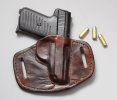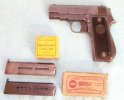Wound ballistics......everything evolves over time. The time period 1890-1910 was in fast-forward, if firearms technology is being discussed. Black powder was being relegated to 2nd tier status by new smokeless fuels that provided more gas volume/pressure per grain, enabling higher velocities that prompted jacketing of bullets. In handguns, self-loading pistols were coming along, though not yet supplanting revolvers in civilian venues. By the end of WWII, the tech was 95% 'built-out' to where we sit in the present day.
This begs the question--why izzit that the 25 ACP, 32 ACP, 32 S&W Long, and other less intense mid-caliber chamberings fell from favor? Again--'everything evolves over time'. But what evolved that caused this loss of favor?
Laws evolved. Medicine evolved.
Law--La Ley de Fuga--Si tu fugas, mi fuego (The Law of Flight--If you flee, I fire)--In the USA and much of the civilized world, this was how armed encounters were assessed. If a suspected felon could not otherwise be brought to justice in some reasonable fashion, it was legal to project lethal force to reduce him/her to custody--armed or not.
Medicine--A gunshot wound didn't need to be immediately fatal to cause death in the time before antibiotics and advaned life-saving medical procedures. Infection and other medical complications caused all manner of horrific deaths to wound recipients throughout history, whether via gunshot, edged weapons, blunt force, you name it. Specific to gunshot wounds, someone hit by a police or citizen gunshot was very likely to show up at some point at an aid station, emergency room, etc. to seel treatment. Laws have existed for decades that require immediate notification to the authorities by medicos of any person seeking treatment for gunshot wounds (and other similar trauma). Most GSW victims get reported to the cops, so the cops can start inquiries into the occurences. On account of our advancing medical tech and antibiotics, many GSWs that would have been ultimately fatal in years past are now survivable. I am one such victim myself.
Another Law--The Law of Unintended Consequences--comes to the fore when we start breaking these two above Laws into the modern milieu. The Law has evolved--the shooting of fleeing unarmed suspected felons is pretty much a thing of the past. Just don't. OK, so the unarmed baddies shouldn't be engaged--CHECK. Can fleeing armed baddies be shot at? Maybe. If they are engaging you or others unlawfully, that's better. No guarantees, though.
So who gets shot lawfully? Violent offenders in the process of projecting lethal force/threats and/or great bodily harm upon self or others. Basically, people attacking us in aggravated fashion. Such folks need to be stopped and turned off MUI PRONTO. And they are attacking, not fleeing. THIS IS WHY THE 25 ACP, 32 ACP, 32 S&W Long, et al are no longer popular as felon repellant. Marking pellets won't save your life.
Not the first time I've mentioned this, but there are new folks on board now so......enjoy.



